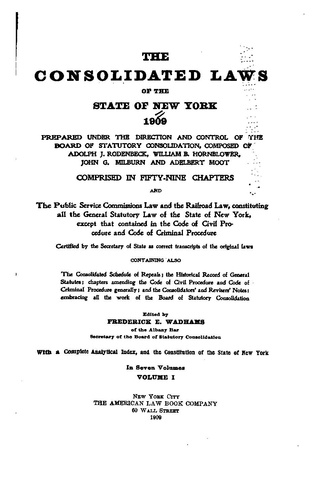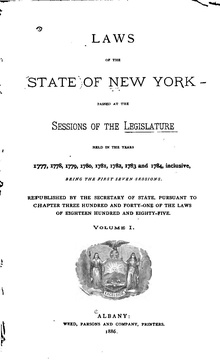
The Appellate Divisions of the Supreme Court of the State of New York are the intermediate appellate courts in New York State. There are four Appellate Divisions, one in each of the state's four Judicial Departments.

The California State Legislature is a bicameral state legislature consisting of a lower house, the California State Assembly, with 80 members; and an upper house, the California State Senate, with 40 members. Both houses of the Legislature convene at the California State Capitol in Sacramento. The California state legislature is one of just ten full-time state legislatures in the United States. The houses are distinguished by the colors of the carpet and trim of each house. The Senate is distinguished by red and the Assembly by the color green, inspired by the House of Lords and House of Commons respectively.

The New York State Legislature consists of the two houses that act as the state legislature of the U.S. state of New York: The New York State Senate and the New York State Assembly. The Constitution of New York does not designate an official term for the two houses together; it says only that the state's legislative power "shall be vested in the senate and assembly". Session laws passed by the Legislature are published in the official Laws of New York. Permanent New York laws of a general nature are codified in the Consolidated Laws of New York. As of January 2021, the Democratic Party holds supermajorities in both houses of the New York State Legislature, which is the highest paid state legislature in the country.

The government of New York City, headquartered at New York City Hall in Lower Manhattan, is organized under the New York City Charter and provides for a mayor-council system. The mayor is elected to a four-year term and is responsible for the administration of city government. The New York City Council is a unicameral body consisting of 51 members, each elected from a geographic district, normally for four-year terms. All elected officials are subject to a two consecutive-term limit. The court system consists of two citywide courts and three statewide courts.

The New York Court of Appeals is the highest court in the Unified Court System of the State of New York. The Court of Appeals consists of seven judges: the Chief Judge and six Associate Judges who are appointed by the Governor and confirmed by the State Senate to 14-year terms. The Chief Judge of the Court of Appeals also heads administration of the state's court system, and thus is also known as the Chief Judge of the State of New York. Its 1842 Neoclassical courthouse is located in New York's capital, Albany.
The government of Texas operates under the Constitution of Texas and consists of a unitary democratic state government operating under a presidential system that uses the Dillon Rule, as well as governments at the county and municipal levels.

The secretary of state of New York is a cabinet officer in the government of the U.S. state of New York who leads the Department of State (NYSDOS).

The government of the State of New Jersey is separated into three distinct branches: legislative, executive, and judicial. The powers of the State of New Jersey are vested by the Constitution of New Jersey, enacted in 1947, in a bicameral state legislature, the Governor, and the state courts, headed the New Jersey Supreme Court. The powers and duties of these branches are further defined by acts of the state legislature, including the creation of executive departments and courts inferior to the Supreme Court.

The Government of the State of New York, headquartered at the New York State Capitol in Albany, encompasses the administrative structure of the U.S. state of New York, as established by the state's constitution. Analogously to the US federal government, it is composed of three branches: executive, legislative, and judicial. The head of the executive is the governor. The Legislature consists of the Senate and the Assembly. The Unified Court System consists of the Court of Appeals and lower courts. The state is also divided into counties, cities, towns, and villages, which are all municipal corporations with their own government.

The Annotated Code of Maryland, published by The Michie Company, is the official codification of the statutory laws of Maryland. It is organized into 36 named articles. The previous code, organized into numbered articles, has been repealed.

The Judiciary of New York is the judicial branch of the Government of New York, comprising all the courts of the State of New York.
The Judicial Conference of the State of New York is an institution of the New York State Unified Court System responsible for surveying current practice in the administration of the state's courts, compiling statistics, and suggesting legislation and regulations. Its members include the Chief Judge of the New York Court of Appeals and judges from the New York Supreme Court, Appellate Division.
The Stanley Plan was a package of 13 statutes adopted in September 1956 by the U.S. state of Virginia. The statutes were designed to ensure racial segregation would continue in that state's public schools despite the unanimous ruling of the U.S. Supreme Court in Brown v. Board of Education (1954) that school segregation was unconstitutional. The legislative program was named for Governor Thomas B. Stanley, a Democrat, who proposed the program and successfully pushed for its enactment. The Stanley plan was a critical element in the policy of "massive resistance" to the Brown ruling advocated by U.S. Senator Harry F. Byrd Sr. The plan also included measures designed to curb the Virginia state chapter of the National Association for the Advancement of Colored People (NAACP), which many Virginia segregationists believed was responsible for "stirring up" litigation to integrate the public schools.

The law of New York consists of several levels, including constitutional, statutory, regulatory and case law, and also includes local laws, ordinances, and regulations. The Consolidated Laws form the general statutory law.

The Consolidated Laws of the State of New York are the codification of the permanent laws of a general nature of New York enacted by the New York State Legislature.

The City Record is the official journal of New York City. It is published each weekday and contains legal notices produced by city agencies, including notices of proposed and adopted rules, procurement solicitations and awards, upcoming public hearings and meetings, public auctions and property dispositions, and selected court decisions. Despite the publication's importance, long history, and influence—many city projects are required to be announced in the paper—the existence of the Record is not well known.
The New York Legislative Bill Drafting Commission (LBDC) aids the New York State Legislature in drafting legislation; advises as to the constitutionality, consistency or effect of proposed legislation; conducts research; and publishes and maintains the documents of the Legislature. It is composed of two commissioners.
The Administrative Code of the City of New York contains the codified local laws of New York City as enacted by the New York City Council and Mayor. As of January 2018, it contains 35 titles, numbered 1 through 16, 16-A, 17 through 20, 20-A, 21, 21-A, and 22 through 32.
The Rules of the City of New York (RCNY) contains the compiled rules and regulations of New York City government agencies. It contains approximately 6,000 rules and regulations in 71 titles, each covering a different city agency. The City Record is the official journal of New York City. The rules can also be viewed and the public can comment on the city's rules website - NYC Rules.
The New York State Commission on Judicial Conduct is an eleven-member panel with authority to discipline judges of the New York courts. The Commission is constitutionally established to investigate and prosecute complaints filed against New York judges.











